#Humboldt Squid
Explore tagged Tumblr posts
Text
So a while back I made this post

And it became very popular. While many people already knew, I did get some asking why humboldt squids are scary. So for this Wet Beast Wednesday I'm going to teach you why you should be afraid, or at least respectful, of molluscoid menace that is the humboldt squid.

(image: a humboldt squid)
Known to scientists as Dosidicus gigas and to many others as the jumbo squid, pota, jibia, and diablo rojo, the humboldt squid is the 5th largest squid in the world and the largest of the flying squids. Don't worry, it can't actually fly. They reach an average mantle length (tat's excluding the head and arms) of 1.5 meters, with some specimens reaching up to 2 meters (6.5 ft) in mantle length. The arms can reach up to another meter in length. Adults can weigh up to 50 kg (150 lbs), with females generally being larger than males. They live in the Pacific along the cost of the Americas, from the tip of South America up to California in North America. Some individuals have been known to travel farther north, up to Alaska, which is outside of their historical range. It is possible that as the ocean warms, their native range will continue to expand north.
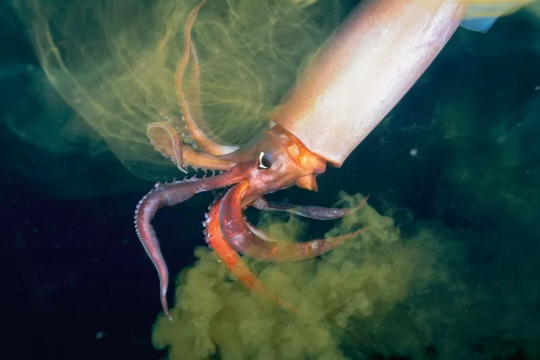
(image: a humboldt squid releasing ink as a defense mechanism)
Humboldt squids reproduce in deep waters, and as a result we don't know much about their courtship. Males use a modified arm called the heterocotylus to transfer sperm into the female's mantle. She then lays a transparent, gelatinous egg mass that is left to float in the water column. These masses can range between 1 and 4 meters in diameter can can contain up to 4 million eggs. Hatchlings receive no parental care and most will die before adulthood. They grow extremely rapidly, likely as a self-defense against cannibalism by larger squids. Like many squid, humboldts only live for a year and die shortly after mating.

(image: a humboldt squid next to a much braver diver than I will ever be)
As with most cephalopods, the humboldt squid has cells called chromatophores that allow it to change color. Cameras attached to captured and released specimens have show two types of color-changing behavior: flashing and flickering. Flashing is when the animal changes rapidly between red and white. This is done in the presence of other squid and is likely a means of communication, possibly a form of courtship or warning to stay away. Flickering is when waves of red and white travel down the body. This is likely a form of camouflage to blend in with light flickering through the water. In addition to flashing and flickering, cameras have seen multiple forms of color changes and communication behaviors, indicating that they have a rich social life. The red color the squid turns when hunting contributes to its nickname amongst Mexican fishermen: "diablo rojo", the "red devil".

(gif: humboldts changing color)
So all that sounds pretty normal, why are they scary? Well that comes down to their feeding behavior and aggression. Humboldt squids hunt in shoals that can include thousands of members and go into feeding frenzies that can make shark feeding frenzies look like a child's tea party. They are infamous for their aggression and there are many stories of them attacking divers and fishermen. Not even they are immune to their predation, as multiple studies have found between a half and a quarter of all dissected specimens have recently fed on others of their species. Cannibalism may make up a major portion of their diet, though cannibalistic behavior seems to increase in response to stress. Their typical diet consists of fish, crustaceans, and other squids. Humboldts typically keep their two long tentacles coiled up between their arms, only for them to suddenly lash out and grab prey. These tentacles have multiple sharp hooks that have been reported to cause severe cuts in humans. Captured prey is then pulled in toward the beak and consumed. Feeding happens so fast that scientists need to us high-speed cameras to record the capture as the tentacles move so fast they prey can be caught and reeled in between frames. Eating is also fast enough that they can grab a hooked fish and skeletonize it in the time it takes a frustrated angler to pull their catch in. And if that wren't enough, they also engage in cooperative hunting, working together to catch prey. When not feeding or being hunted, they have been described as curious, though they often react to unfamiliar stimuli with aggression. Some divers have reported that humboldts will come investigate them and even act friendly, though I can't say I'd be willing to try it.
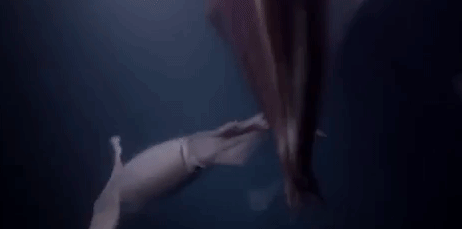
(gif: a squid attacking a camera)
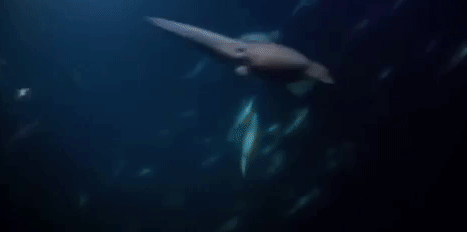
(gif: hunting squid)
Numerous fishermen's tales and news stories tell of attacks on humans, but the squid do have a reason to not like us. They are fished heavily, especially off the coat of Mexico and are the most important squid for commercial fisheries. Humboldt squids make up about a third of all squid fished every year and are the most popular food squid. Squid meat is saturated with ammonium chloride, which they use for buoyancy, and must be prepared to remove the taste before eating. Not much is known about threats to conservation, though some speculate that overfishing and global warming disrupting their food supply could threaten the population. They are listed as data deficient by the IUCN. As scary as they might be, humboldt squids serve a very important ecological role in their territories, both as primary predators and as prey to sharks and toothed whales, and more research on their sustainability and conservation needs is important.
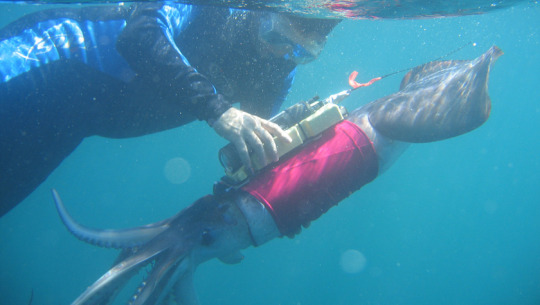
(image: a scientist attaching a crittercam to a humboldt squid)
#wet beast wednesday#marine biology#biology#zoology#animals#ecology#animal facts#humboldt squid#jumbo squid#squid#cephalopod#that last picture is adorable#he has a little vest!
2K notes
·
View notes
Note
May I humbly request the Humboldt squid?
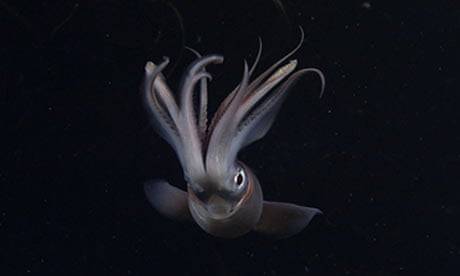
Daily Cephalopod #149
#squid#humboldt squid#thanks for 4000 guys 😳#squid mail くコ:彡#GOOBERS!!!#daily cephalopod#cephalopod#marine life#ocean creatures#ocean critters#marine biology#zoology#animals#biology#cephalopods#marine animals
422 notes
·
View notes
Text
ADOPTABLES!!! WOOHOO (SOLD OUT)
i did all of these for fun, all names are placeholders and you can change their names after taking them. theyre a $1 each but i take tips if you think they are worth more
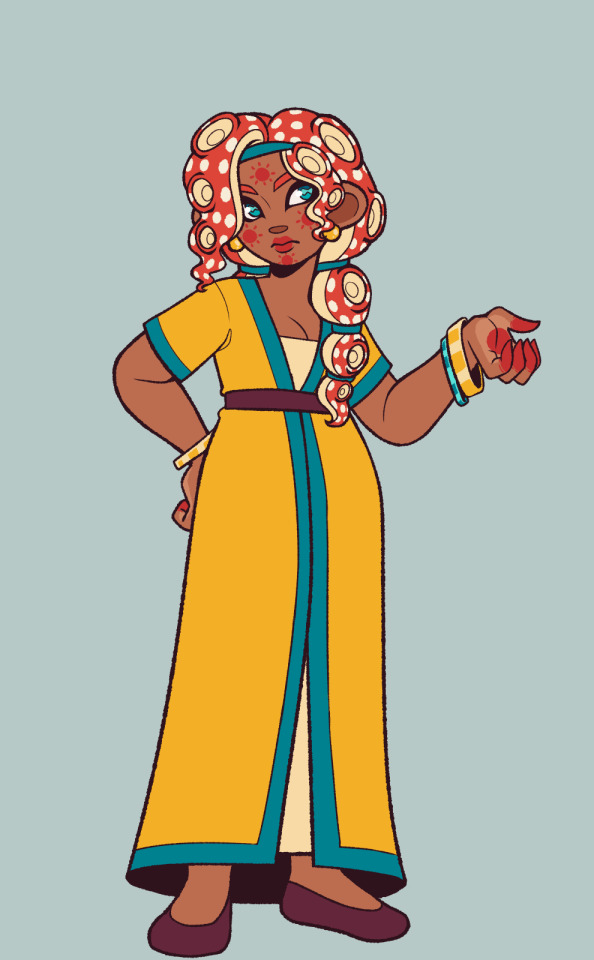


octolings: SOLD Callisto (atlantic spotted octopus), SOLD Bianca (blanket octopus), SOLD Mima (mimic octopus)



inklings: SOLD Margaret (magnapinna squid), SOLD PJ (striped pyjama bobtail squid), SOLD Holly (humboldt squid)
theyre all girls bc like ummmm this is cephalopodyuri, go to cephalopodyaoi for dudes
if these are successful i will make more adoptables
#splatoon#splatoon oc#octoling#inkling#adoptable#character design#magnapinna squid#striped pyjama bobtail squid#humboldt squid#atlantic spotted octopus#blanket octopus#mimic octopus
138 notes
·
View notes
Text
So I'm on vacation to visit my family in Ontario and I went to ripleys aquarium :3
Here's some of my fav fish










#irl p34chy#art#silly billy#FISH#I LOVE FISH SM#marine biology#american paddlefish#lumpsucker#porcupine fish#giant grouper#bull shark#i think#nurse shark#lionfish#weedy seadragon#cuttlefish#round ribbontail ray#stingrays#Humboldt squid
25 notes
·
View notes
Text

So guess what, I wrote another entry to the Dr Gogol fanfic I started a while ago
https://archiveofourown.org/works/60668965/chapters/158390827
Featuring Dr Wong being unusually early at the clinic
#peter lorre#keye luke#mad love#mad love 1935#dr gogol#dr wong#humboldt squid#really running with the squid metaphors here#🦑#drawing#fanart#fanfic
12 notes
·
View notes
Text
Had my quarterly performance evaluation at work today and when my manager asked if I had any questions at the end I asked if he knew that humboldt squid, which grow to around 6 feet long, hunt in packs, and have been known to kill and eat adult humans.
9 notes
·
View notes
Text
What a nice day I sure hope no silly gooby woobies don’t show up

OOOHh NNOoO NOTa HUBoLt SqiD oOH LROd I Su R e HOPe Teh re Arenrt AnY GOoBy WOBiEs Next
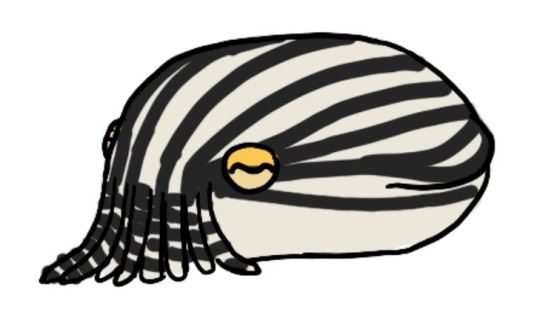
OHHSH SHIT D NOT D THe FKucknimg PaJma SqUdI fUOK NOoOo NTo ThE gObY WooBiers NOO
#art#squid#red devil#Humboldt squid#pajama squid#pyjama squid#bobtail squid#cuttlefish#cephalopod#mollusc
29 notes
·
View notes
Text
After Dark Special Report: Defining a Superspecies
Welcome once again to Monarch: After Dark, the digital gateway between you and the organisation dedicated to understanding and navigating this troubled new world we live in.
We once more find ourselves in the face of a special report from us on the After Dark team, where we wish to cover a different aspect of the world we live in. For this report, now that we have started coverage of creatures other than the Titans, we felt it was best to cover this particular issue as early as possible to avoid misconceptions moving forward.
In recent times, there has been some confusion over what is classified as a Titan, what is classified as a superspecies, and how Monarch go about defining creatures as either term. So, for today, sit down and prepare yourselves for a lesson from Monarch directly on how to define a superspecies

(Pictured above: A chalkboard image with text on it...we like to have fun here)
Monarch Classification 101: How to Define a Superspecies
The short version, and the generally accepted definition within Monarch's ranks, is that the term "superspecies" is a general catch-all used for unique flora and fauna that have their origins within the Hollow Earth, with close association to the subterranean world itself and the Titans.
Titans are something of a higher order of superspecies, colossal creatures that serve specific functions in maintaining the balance of the planet. Size does not appear to be a qualifying factor in classifying a creature as a Titan. Rather, more unique attributes such as the range of territory they can cover, resistance to conventional weaponry, and unique abilities that aid them in their functions are taken into consideration.
Within the catch-all of "superspecies", there are further divides when it comes to classifying creatures. There are standard superspecies, which are typical biological megafauna, "florafauna", which encompasses creatures that have evolved with plant-like attributes within their genetic composition, and "magmafauna", which encompasses animals that have evolved hyperspecific traits that allow them to thrive in volcanic environments. Florafauna additionally consists of plants that have evolved to take on animal-like genetic traits.
-----
Part One: What Makes a Superspecies?

(Pictured above: A Humboldt squid. Its close genetic relation to the Shocker Squids of Skull Island disqualify the latter from being classed as a superspecies)
As is the case when it comes to defining Titans, there are no size qualifications to consider. Some superspecies, such as the Leafwings, are rather tiny creatures, while others such as the Warbats of Hollow Earth can reach sizes equivalent to those of the larger Titans.
One factor that does seem to strongly weigh on whether or not a creature is classed as superspecies is their genetic relation to existing fauna on the surface world. The immediate example of this are the Shocker Squids that live in Skull Island's waters. Study of these animals found that they were closely linked to the Humboldt squid genetically, and close enough that they were ultimately disqualified from being counted as superspecies.
Across the board, superspecies seem to be distantly related to existing fauna, but have undergone such radical evolution that they are almost entirely unique compared to their relatives. For example, the Psychovultures are classified by Monarch as belonging to the family Ctenochasmatoidea, despite that fact that they are virtually unrecognisable as pterosaurs. Other superspecies seem to have their own unique classifications, such as the Necroserpere group, which contains the Skullcrawlers (distantly related to amphibians) and Death Jackals (distantly related to theropod dinosaurs). A common thread between both species is a constant need to feed in an effort to satisfy a neverending hunger.
While there is much we are yet to understand about the specifics of the origins for superspecies and how exactly they come to be, behavioural traits, unique genetic anomalies (which will be covered in greater detail soon) and a considerable relation distance from existing flora and fauna are the current determining factors between a superspecies and more typical creatures that inhabit our world.
-----
Part Two: What are Florafauna and Magmafauna?

(Pictured above: A Tree Mimic, a unique reverse example of florafauna, where a plant has developed animalistic traits)
Underneath the catch-all umbrella of superspecies, there exist two additional subcategories that further push the boundaries of what sort of creatures can exist within our world. We will examine both, to showcase how an organism could be categorised within them.
We will begin with florafauna, the more widely known of the two subcategories. The concept is fairly simple to understand; florafauna covers all range of animals that have evolved to develop unique physiological traits that are very similar to those of plants. The largest known example of florafauna on record is the Titan Amhuluk, which uses plant material to construct bodies for itself, due to lacking a natural body of its own.
Most documented florafauna have been found on Skull Island, with many using their unqiue characteristics as a form of camouflage to blend in seemlessly with the environments of the island. Recently, however, there was the discovery of the Tree Mimic, a plant species that has taken on animal traits and behaves like an ambush predator. It is so far the only documented instance of "faunaflora", the reverse instance of florafauna.
Magmafauna, a more recently discovered sub-division of superspecies, is a far rarer occurence. This category encompasses superspecies that have developed physiological and physical traits that allow them to thrive within superheated and volcanic environments, places that most creatures would be unable to survive within.
Currently, only two examples of magmafauna are currently known to Monarch's database; the Magma Turtle of Skull Island, and the Titan Rodan (the subject of our previous communication). For the time being, this is all we are able to really report on the subject of magmafauna until more instances emerge.
-----
Part Three: What Makes a Titan?

(Pictured above: Godzilla in Pensacola, Florida. Godzilla is the most well-known and recognised of the Titans in the public eye)
Classifying the Titans, in comparison to more general superspecies, is a rather challenging task, even to those who have dedicated several years to studying them. While perhaps not always the case, Titans are generally gargantuan animals, with sizes ranging from 100 feet (roughly the height of Kong during his adolescence in 1973) to the 521-foot Monster Zero. Their impressive size, paired with a range of abilities seemingly unique to each Titan, makes each one a potentially catastrophic threat.
One factor in classifying a Titan is the territorial range that they cover. Godzilla, for instance, heavily patrols the world's oceans as his territory, often responding violently to those he percieves as trespassing (e.g. Kong during the 2024 Hollow Earth expedition). The Mire Squid of Skull Island, while growing to sizes rivalling small Titans, is disqualified from being classed as a Titan itself due to its territory only covering Skull Island, among other factors.
A second factor to consider is the creature's vulnerability to conventional weapons. To use the Mire Squid again as an example, its vulnerability to conventional weapons is another disqualifying factor. Most Titans are heavily resilient to military weapons, and even attacks from other Titans. Notable feats of Titan durability include Rodan's survival of Godzilla's thermonuclear attacks on Monster Zero, or Godzilla enduring multiple nuclear detonations over the decades.
A third factor is that each Titan fulfils a specific function aiding in the overall balance of our world's natural order, with special abilities to help them do so. Behemoth can regrow damaged forests in an instant, Scylla had the power to cool down the global climate (though she began warming it instead whilst gorging on radiation sources), Amhuluk destroys forests and acts as a check for Behemoth, and Godzilla maintains balance by going after direct threats to the natural order, be they manmade or from monsters that threaten the world. Creatures that do not serve a function in balancing the natural order (e.g. Skull Devils or Snarehunter Queens) are not Titans, even if they may meet other qualifying factors.
All Titans are deeply entrenched in Earth's mythologies, dating back thousands of years. Worshipped as gods by multiple ancient civilisations, even dating back to humanity's days as dwellers in the Hollow Earth, the Titans have left a distinct mark on history that no other superspecies has. Many Titans are even directly named after the mythological dieties they inspired.
Unlike other superspecies, Titans are difficult to classify into suborders relating to existing fauna. Recently, a development has shown itself providing evidence that there is an element of genetic hybridisation involved with the Titans, that they take in DNA from other organisms across the years. Godzilla's slaying of Tiamat, Monarch uncovered, resulted in Godzilla absorbing some of her DNA as well as the radiation from her domain. Further investigation into this phenomena is required.
-----
Concluding Remarks

(Pictured above: Monarch's superspecies profile on the Mire Squid, a large superspecies that is prevented from being classed as a Titan due to multiple disqualifying factors)
And, that's our lesson concluded! We hope all those who have read until the end have enjoyed learning more about the specifics of how Monarch go around identifying superspecies and Titans as we discover them.
As our understanding of these magnificent creatures and their world grows, the information we have presented here may change if new discoveries go against our current understanding. Of course, the After Dark team will be on-hand to keep you all updated.
Thank you, and until next time,
Monarch: After Dark
#monarch#monarch after dark#monsterverse#godzilla#kong skull island#godzilla king of the monsters#godzilla vs kong#godzilla x kong the new empire#monarch legacy of monsters#skull island#titanus gojira#mire squid#humboldt squid#superspecies#titans#megafauna#florafauna#magmafauna
18 notes
·
View notes
Note
Opinion on Humboldt Squids? I love them they’re such evil little bastards
they're sure an animal! i cannot get over how they simultaneously engage cooperative hunting, and cannibalism. like. so much cannibalisim. yeah sure they'll work together but the second one gets injured they are now also on the menu. to the point where eating other Humboldt squids is a major part of their diet. and it works.
surprising no one, the second they were brought up in regards to law of the deep i immediately went "thats Excelsius Winner." theres so much wrong with the both of them they're a match made in narrative parallels.
9 notes
·
View notes
Text


Humboldt squid. Easily the best type of squid. I don’t care if they’re aggressive and they hate me, they’re adorable
8 notes
·
View notes
Text
Animal of the Day for November 12: Humboldt Squid (Species Dosidicus gigas)

While not quite the size of Giant and Colossal Squids, Humboldt Squids are among the largest known species of squid. They are known to hunt in groups of over a thousand individuals and are aggressive and are known to attack humans, luckily they spend most of their time in the deep sea. Humboldt Squids are nicknamed 'Red Devils' due to their ability to change color to communicate, because they flash red when distressed.
#animal of the day#november 12#november#humboldt squid#cephalopods#invertebrates#pacific ocean#mollusk
8 notes
·
View notes
Text

When Vinestaffs new skin dropped , Raine had hyperfixtion moment and made a mer version of Seer
So I present too you : Squid-Seer!
Based on a Humboldt squid
#Woomy! Detective#Phighting#phighting!#phighting oc#roblox phighting#Roblox#humboldt squid#Merfolk#Overseer#Squid-seer#Art#my art#my ocs#ocs#yeh
22 notes
·
View notes
Text
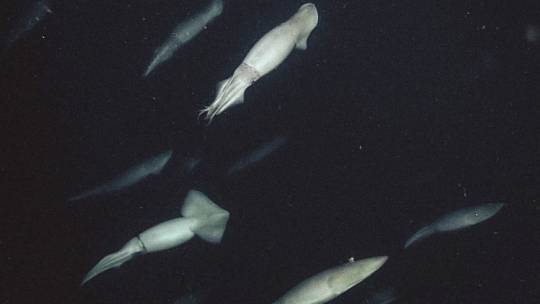
Daily Cephalopod #28
#squid#humboldt squid#daily cephalopod#cephalopod#cephalopods#marine life#marine critters#marine creatures#marine animals#marine biology#ocean creatures#ocean critters#ocean animals#ocean life#sea animals#sea life#sea creatures#biology#zoology#animals
922 notes
·
View notes
Text
Motherfuckers talk too much about the Megaladon as if it’s the scariest thing to ever exist in the ocean and “ooo wouldn’t it be nuts if it’s still alive down there today!?”
As if there weren’t vastly more terrifying animals already living down there.
I present: The Humboldt Squid.

Don’t think it’s all that scary next to a gigantic great white shark?
Well… it averages about 5ft in length (i.e. about as long as most people) and weighs an average of 110lbs.
They travel in shoals of 1,200 individuals, have a reputation of being aggressive towards humans (although this may only be under specific circumstances), and have been seen migrating as far north as Alaska from the warmer waters off of Mexico.
Colloquially, they’re sometimes called “Diablo Rojo” or “Red Devil” for their tendency to flash red and white colors while attacking.
Fuck the (extinct) giant shark, there’s much scarier things in the ocean as is already.
#humboldt squid#El Diablo Rojo#squid#yes they’re scarier than sharks#yes I will slander the Megaladon whenever the opportunity presents itself#people who think that the Megaladon is still alive lack imagination#no it’s not hiding in the deepest parts of the ocean either#the deep sea floor is basically a vast and empty desert where the largest animals are the corpses of whales
6 notes
·
View notes
Text
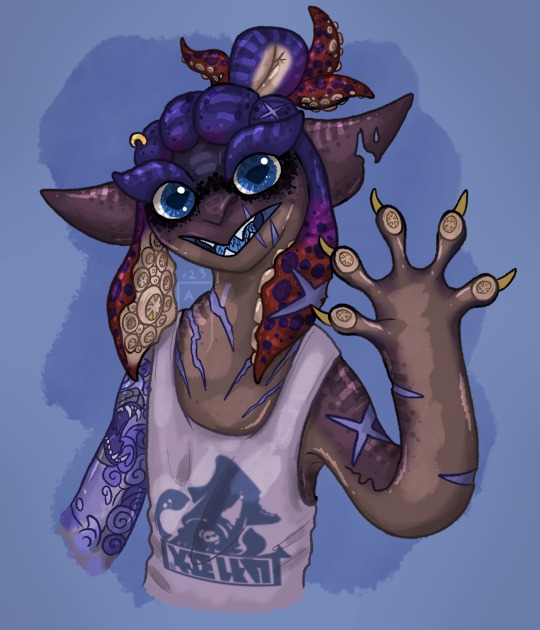
AF Day 1: Peppermint! Best girl! The Cephalopod (real)!
She belongs to @dogtoling! Go check them out!
#this turned out so much better than i thought it would lmao#Also it’s friendly fire but idc i’m doing this for fun lol#My art#Splatoon#xeno inkling#inkling#artfight#art fight 2023#squid#splatoon art#Humboldt squid#inkling oc
106 notes
·
View notes
Text
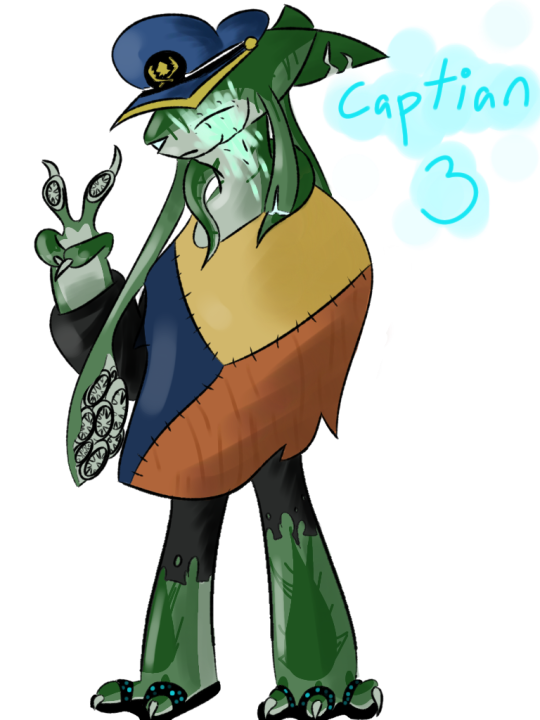
Got bored so drew Captain 3, she a Humboldt squid
22 notes
·
View notes